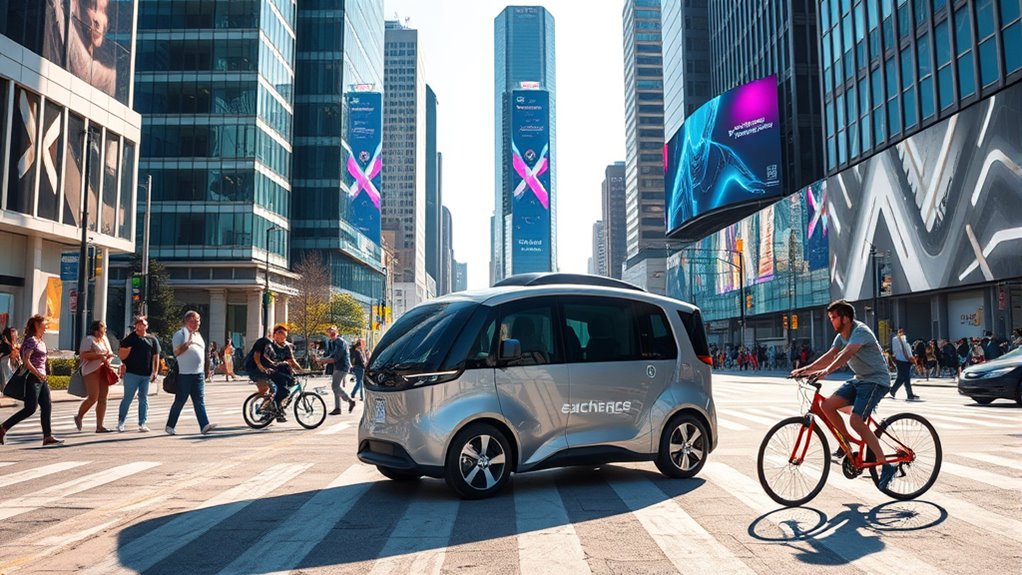Autonomous vehicles are making impressive strides, using sensors and AI for safer, efficient driving without human control. Companies like Tesla and Waymo are leading the charge, but challenges remain. Safety concerns around accidents spark questions of liability, while outdated infrastructure and adverse weather can hinder performance. Plus, public skepticism and security vulnerabilities need addressing for wider acceptance. To get a better overview of these complexities, you’ll find more insights ahead.
Key Takeaways
- Autonomous vehicles utilize advanced sensors and AI, enabling them to navigate and make decisions without human intervention, marking significant technological progress.
- Companies like Tesla and Waymo are leading the development of semi-autonomous and fully autonomous driving systems, increasing public acceptance and interest.
- Safety and liability challenges arise from accidents involving autonomous vehicles, necessitating clear legal frameworks to determine accountability.
- Outdated infrastructure and adverse weather conditions can hinder the performance of autonomous vehicles, posing challenges for their reliable deployment.
- Public skepticism regarding safety, control, and security risks must be addressed to foster trust and facilitate the transition to autonomous vehicle adoption.

What if you could sit back and relax while your car navigated the roads for you? Autonomous vehicles, or self-driving cars, are making that dream a reality. These advanced machines use a combination of sensors, cameras, and artificial intelligence to interpret their surroundings, make decisions, and drive without human intervention. Imagine not having to worry about traffic jams or parking; your car would handle it all.
Imagine a world where you can unwind while your car takes care of navigation, traffic, and parking all on its own.
The progress in this field has been astounding. Companies like Tesla, Waymo, and others are continuously testing and refining their technologies. They’ve made significant strides in safety, efficiency, and convenience. For instance, Tesla’s Autopilot feature allows for semi-autonomous driving on highways, which can reduce driver fatigue during long trips. As public acceptance grows, more people are beginning to see the potential benefits of this technology.
But it’s not all smooth sailing. There are several challenges that the industry faces. One major concern is safety. While the technology has proven to be effective in many scenarios, accidents involving autonomous vehicles raise questions about liability and accountability. If your self-driving car gets into a crash, who’s responsible? You, the manufacturer, or the software developers? These questions need clear answers before widespread adoption can occur.
Another challenge lies in the infrastructure. Roads, traffic signals, and signs must be designed to work seamlessly with these vehicles. In many areas, outdated infrastructure can create obstacles. Additionally, weather conditions can affect how well these systems operate. Rain, snow, or fog can obscure sensors and cameras, making it difficult for a car to navigate safely. As a driver, you’d want to guarantee your vehicle can handle all types of conditions effectively.
Then there’s the issue of public perception. Many people remain skeptical about the reliability of self-driving cars. They’re worried about losing control over their vehicles and the potential for hackers to exploit vulnerabilities in the software. Adopting new technologies like autonomous vehicles will be vital for addressing these fears and ensuring a smoother transition to this innovative mode of transport.
Frequently Asked Questions
How Do Autonomous Vehicles Impact Insurance Rates and Policies?
Autonomous vehicles can considerably impact insurance rates and policies. As these vehicles become more prevalent, you might see lower premiums due to reduced accident risks. Insurers may also adjust policies to cover unique liabilities related to autonomous technology. However, initial costs could rise as companies adapt to new regulations and risk assessments. Staying informed about these changes will help you navigate your insurance options effectively in this evolving landscape.
What Are the Environmental Effects of Widespread Autonomous Vehicle Use?
Widespread use of autonomous vehicles can considerably reduce emissions by optimizing driving patterns and decreasing traffic congestion. You’ll notice that these vehicles often promote electric models, further lowering carbon footprints. However, increased convenience might lead to higher overall vehicle usage, potentially offsetting some environmental benefits. As you embrace this technology, it’s essential to take into account its effects on urban planning, resource consumption, and how it might influence public transportation systems in your area.
How Do Different Countries Regulate Autonomous Vehicle Testing?
Different countries regulate autonomous vehicle testing in various ways. In the U.S., states set their own rules, leading to a patchwork of regulations. The European Union focuses on harmonizing standards across member countries, while countries like China impose strict government oversight. You’ll find that some nations prioritize safety and public trials, while others emphasize innovation and rapid deployment. Staying updated on local laws is essential if you’re involved in this field.
What Are the Ethical Considerations in Programming Autonomous Vehicles?
When it comes to programming autonomous vehicles, you’ve got to contemplate a few delicate dilemmas. These vehicles need to make split-second decisions in unpredictable situations, which often involve weighing human lives against one another. You’ll also need to think about fairness, accountability, and transparency in their decision-making processes. Plus, there’s the matter of data privacy, ensuring that personal information isn’t mishandled. It’s a complex balance, but it’s essential for building trust in this technology.
How Are Public Perceptions of Safety Influencing Autonomous Vehicle Adoption?
Public perceptions of safety play a huge role in how you view autonomous vehicle adoption. If you’re concerned about their safety, you’re less likely to embrace the technology. Media coverage and personal experiences shape your opinions, often highlighting accidents or failures. As you see more successful deployments and positive testimonials, your confidence might increase. Ultimately, your perception can either accelerate or hinder the acceptance of autonomous vehicles in everyday life.
Conclusion
In summary, while some may worry about safety and reliability, it’s important to recognize that autonomous vehicles are designed with cutting-edge technology that prioritizes these very aspects. As we continue to advance, the potential for safer roads and reduced traffic congestion becomes more tangible. Embracing this innovation opens up a world of possibilities, transforming transportation as we know it. So, let’s look forward to a future where these vehicles can enhance our daily lives and communities.








